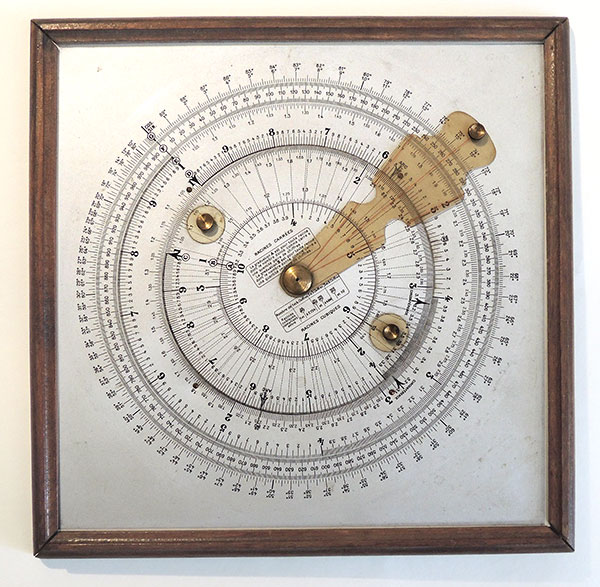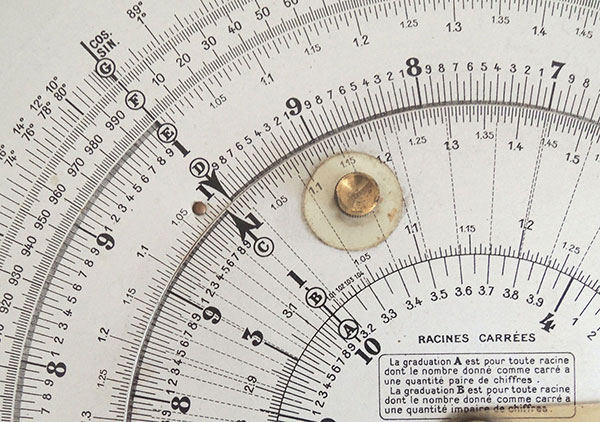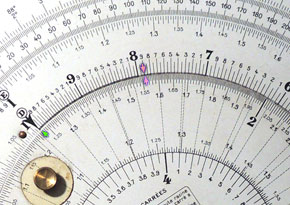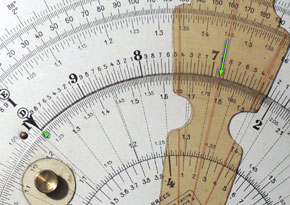 |
 Up
Up
|
|

|

|
Pretty as a picture! |
|
|
|
|
|
|
When this one arrived, I thought the wooden frame must’ve been added by a previous collector who had wanted to hang the calculator on a wall for decoration. But I soon learned that the frame is original, and must’ve been included to provide the thin device some sturdiness – for protection and to facilitate its handling by the user. That settled, I did proceed to hang it on a free spot on my den’s wall – I’ve run out of drawer space, and besides, the thing certainly is pretty as a picture! |
|
|
|
 Click photo to enlarge |
|
|
|
This calculator has no maker name or model on
it, but some inquiry placed it as the “Calculateur a Disque Mobile”
– calculator with a moveable disk – invented in France by Jules
Arnault and Louis Paineau and patented by them in 1921. The manual
bears a copyright by Mathieu et Lefevre, Montrouge (a suburb of
Paris), the firm that fabricated the device. The calculator, whose frame measures 26.5 cm on a side, is a circular slide rule assembled on a square metal plate. As such, it has a disk with various scales – the “Disque Mobile” – that rotates on a pivot; a stationary plate bearing a set of concentric fixed scales surrounding the disk; and a radial celluloid cursor (with three hairlines). It is very well-built, and after a century still looks great. The sturdy metal plate and disk look like aluminum, but aren’t – a test with a magnet shows them to be ferrous, probably a steel alloy plated with a silvery-white coating. This coating gives the lithographed black scales an excellent contrast usually missing in metal rules. The cursor is made of celluloid that has yellowed with time as celluloid is wont to do, but hasn’t cracked or shrunk. To help moving them, the cursor and disk have knurled brass knobs attached (the flexible cursor can be moved over the knobs on the disk by pulling it up away from the surface). The only imperfection in my exemplar is that the frame had warped a bit, so it doesn’t lay quite flat on the table as it had when it was made. At first glance this looks like your usual circular slide rule, but when you look more closely you notice the differences. The most unusual design feature is that the two juxtaposed scales at the interface between disk and the plate, named C and D, are not identical (as they are on a standard slide rule). They are both one-cycle logarithmic scales, but they run in opposite directions – the one on the disk increments clockwise and the other counter-clockwise. They are, in effect, equivalent to the C and CI scales of a standard slide rule – but here they slide next to each other, a fact that is the key to some rapid calculation techniques unique to this calculator. This unusual setup provides the ability to multiply two numbers with one movement of the disk, and to simultaneously multiply or divide the product by any third number (see example below). The calculator has seven scales, marked (from the center outward) with the letters A through G, which serve the following functions: |
|
|
|
 Click photo to enlarge |
|
|
|
Operation of the calculator can be understood
from the scale descriptions above, except for multiplication (and,
conversely, division) with the C and D scales. To multiply two
numbers, you turn the disk to align the two multiplicands with each
other, one on the C scale and one on the D scale. That done, the
result will be found on either of these scale opposite the arrow of
the other scale. The situation is fully symmetrical – it doesn’t
matter which scale has which of the two multiplicands, nor which
scale you use to read the result – the arrow of either scale
will point it out on the opposite scale. |
|
|
|

 Click a photo to enlarge |
|
|
|
Division is executed by pointing the arrow of
either the C or D scale at the dividend on the other scale, and
reading the result on either scale across from the divisor on the
opposite scale. In addition to squares and square roots, the manual points out an easy process for deriving cubes and cubic roots – for the former, for example, you take the number on the A or B scale and turn the disk so it aligns (via the cursor hairline) with the same number on the D scale; the cube is now indicated by the arrow of either C or D. There are of course more details. The “Circonférence” and “Arc” arrows, notably, are useful in converting diameter to circle circumference, and radius and angle to arc length, respectively. The manual is full of other handy calculations, with examples. So, I can conclude by saying that this device is much more than pretty; it is sophisticated, useful, and quite ingeniously designed. Kudos to MM. Arnault and Paineau! |
|
|
|
Exhibit provenance: eBay, from a seller in Czechoslovakia. More info:
|
|
|
|
|
|
|
|
Home | HOC | Fractals | Miscellany | About | Contact Copyright © 2019 N. Zeldes. All rights reserved. |
|